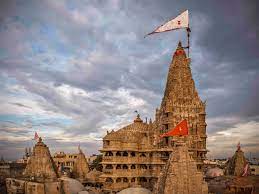Throughout history, humanity has been captivated by the allure of lost civilizations – grand metropolises swallowed by sand dunes, opulent palaces submerged by rising seas, and forgotten empires shrouded in myth and legend. These remnants of the past whisper tales of bygone eras, waiting to be rediscovered. But how do we, armed with modern technology and scientific methods, unearth these hidden worlds? The answer lies in the powerful tools of geography, a discipline that allows us to analyze landscapes, interpret historical texts, and piece together the puzzle of the past. One such lost city that continues to ignite the imaginations of Indians is Dwarka, the legendary kingdom of Lord Krishna, the most adorable God in Hinduism.
The Stories of Sri Krishna’s Capital, Dwarka are known to all through our mega epics, Mahabharata and more specifically Bhagavatam. These texts describe Dwarka as a magnificent city built by the divine architect Vishwakarma, boasting opulent palaces, towering gateways, and an intricate network of streets. However, the exact location of Dwarka remained a mystery for centuries, its existence debated and dismissed as mere mythology.
This is where the fascinating interplay between geography and archaeology comes into play. Unraveling the secrets of Dwarka required a multi-pronged approach, utilizing:
- Ancient Texts and Oral Traditions: The epic narratives of the Mahabharata and Harivamsa provided crucial clues about Dwarka’s location. These texts described the city as being situated on the western coast of India, near the confluence of the Gomti River and the Arabian Sea. Additionally, local folklore and oral traditions passed down through generations also pointed towards a submerged city off the Gujarat coast.
- Underwater Exploration Techniques: With these textual references as a guide, marine archaeologists embarked on a series of underwater surveys. Advanced technologies like side-scan sonars, magnetometers, and remotely operated vehicles (ROVs) were deployed to scan the seabed and identify potential submerged structures. These instruments can map the underwater terrain, detect anomalies in the seabed that might indicate man-made structures, and even capture high-resolution images of submerged objects.
- Archaeological Excavations: While underwater exploration offered invaluable insights, physical evidence was needed to confirm the existence of a city. Following promising leads from sonar surveys, teams of archaeologists conducted underwater excavations at specific locations. These excavations involved careful dredging and sifting of seabed sediments, potentially unearthing artifacts, architectural features, and other remnants of human habitation.
The Pioneering Work of Dr. S.R. Rao:
A pivotal role in the quest to find Dwarka belongs to the renowned marine archaeologist, Dr. S. Rao. Beginning in the 1980s, Dr. Rao spearheaded a series of underwater explorations off the coast of Gujarat. His team meticulously surveyed a vast area using side-scan sonars and magnetometers. Their efforts yielded intriguing results, including the discovery of submerged formations that resembled gateways, harbor structures, and even city walls. Furthermore, underwater excavations conducted by Dr. Rao’s team unearthed numerous artifacts, including potsherds, beads, and pieces of sculpture, hinting at a rich and vibrant civilization.
Current Government Initiatives and Ongoing Debates:
The Indian government has also recognized the significance of uncovering Dwarka’s secrets. In recent years, several initiatives have been launched to further explore the submerged city. The Archaeological Survey of India (ASI) has undertaken renewed exploration efforts, utilizing advanced technologies like underwater LiDAR (Light Detection and Ranging) to create detailed 3D maps of the seabed. Additionally, plans for a dedicated underwater museum showcasing the artifacts recovered from Dwarka are under consideration.
Despite these advancements, the debate surrounding Dwarka’s existence continues. Some scholars remain skeptical, arguing that the evidence gathered so far is inconclusive. They emphasize the need for more concrete proof, such as the discovery of well-preserved structures or inscriptions that definitively link the submerged city to the Dwarka described in ancient texts.
The Enduring Legacy of Dwarka:
Whether a fully-fledged city or a significant settlement, the evidence points towards the existence of an ancient civilization submerged off the coast of Gujarat. The ongoing exploration of Dwarka serves as a testament to the power of geographic techniques in unlocking the secrets of the past. By combining the wisdom of ancient texts with cutting-edge technology, archaeologists are piecing together a fascinating historical puzzle.
The story of Dwarka’s rediscovery extends beyond mere academic inquiry. It holds immense cultural and religious significance for millions of Hindus who revere Lord Krishna and his legendary kingdom. The possibility of uncovering a tangible connection to their sacred texts fuels their hopes and ignites their imaginations.
Looking Ahead: Unveiling the Mysteries of Dwarka
The quest to definitively locate and understand Dwarka is far from over. Future advancements in underwater exploration technologies, combined with ongoing excavations and meticulous analysis of artifacts, hold the key to unlocking the secrets of this legendary city.
Here are some exciting possibilities that lie ahead:
- Advanced Technologies: Developments in underwater LiDAR, sonar imaging, and robotic exploration will provide even more detailed views of the submerged structures. This could lead to the discovery of well-preserved buildings, harbors, or even inscriptions that definitively link the city to Dwarka as described in ancient texts.
- Deeper Excavations: As technology allows for more precise and controlled underwater excavations, archaeologists might uncover deeper layers of the settlement, potentially revealing older structures and artifacts that shed light on the city’s history and development.
- Interdisciplinary Collaboration: Collaboration between archaeologists, marine geologists, oceanographers, and even Sanskrit scholars can provide a holistic understanding of Dwarka. For example, geologists can help determine the cause of the city’s submergence, while Sanskrit scholars can analyze any recovered inscriptions to decipher the language and script used by the inhabitants.
- Underwater Museum: The creation of an underwater museum showcasing the artifacts recovered from Dwarka would not only be a scientific marvel but also a pilgrimage site for devotees of Lord Krishna. It would allow visitors to experience the city’s legacy in a truly immersive way.
Unveiling the Past’s Significance:
The quest for Dwarka extends beyond mere historical curiosity. Understanding this lost city can provide valuable insights into ancient Indian maritime trade, urban planning, and cultural practices. It can also offer a glimpse into the lives of the people who inhabited this region centuries ago.
The Enduring Allure of Dwarka:
Whether a grand metropolis or a smaller settlement, Dwarka continues to capture our imagination. The ongoing exploration serves as a reminder of the power of perseverance and the enduring allure of lost civilizations. As we delve deeper into the mysteries of Dwarka, we not only unearth the past but also gain a richer understanding of our own place in history.
By: DESU YOGYA DHARANI
Write and Win: Participate in Creative writing Contest & International Essay Contest and win fabulous prizes.















